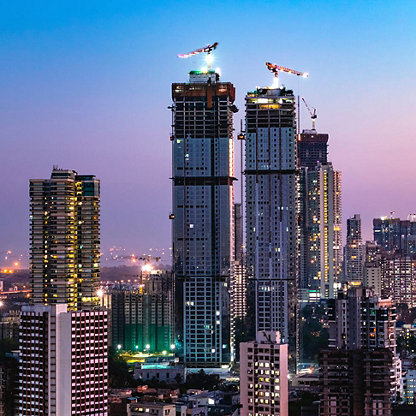What are the critical trends and challenges facing the construction sector in Asia Pacific? Is construction activity across the region is picking up? In our recent webinar, a panel of regional experts discussed these trends alongside the latest results from the RICS Global Construction Monitor. Here, we share the highlights.
Overall construction activity has slowed, but the picture is mixed at the country level
Overall, the headline index for APAC has slightly slowed, compared with previous quarters, explains Donglai Luo, Senior Economist, RICS. ‘At the country level, it is really a mixed picture’, he explains. ‘The headline Index reading for China lost its previous gains after COVID restrictions were lifted in Q1, slipping from a positive ten to a negative ten. China is the only country that saw such sentiment switching in this quarter.’
Sri Lanka is also struggling with deep negative readings, says Donglai Luo. Elsewhere, positive signals were recorded in Singapore (+24), Hong Kong (+13), Australia (+8) and Malaysia (+5), although the signals are indeed softer when compared to the previous quarter.
India continues to show standout growth. Sanjay Dutt FRICS is Managing Director & CEO, Tata Reality and Infrastructure Ltd, and Tata Housing Development Company Ltd. He describes some of the critical figures underpinning this: ‘India offers a stable political environment and attractive investment climate predominantly driven by growing services and lately the manufacturing sector. It is catching up on its infrastructure and building 16,000km of road every year. The privatisation of airports, ports and the monetisation of railways is at accelerated pace. The real estate office market is growing by 50m sq. ft. in the top 8 cities annually (gross absorption), warehousing and logistics 30m sq. ft., shopping centres 10-15m sq. ft. and residential, the largest, is over 300m sq. ft. in top urban centres.’
Comparatively stronger momentum in infrastructure
Turning to the expectations of the workloads split in the next 12 months, there is a similar picture of stronger private sectors in India, the Philippines, and Singapore, says Donglai Luo. Meanwhile, an infrastructure push is expected in other parts of the region. ‘These are really some mixed messages from results at the country level, with some showing strong momentum, while others feature weak private sectors’, he says.
‘It is quite in tune with a lot of what we are seeing on the ground in Australia’, says Niall McSweeney FRICS, President, Cost & Project Management, Asia Pacific, Altus Group. ‘It is still largely dominated by infrastructure within the Australian theatre, both civil/linear and social infrastructure. However, we are starting to see it move more in the next phase, where some of the larger states are starting to slow down on their expenditure in this area.’
“There is a shortage of skill sets, and even certain types of equipment. This demand for parts and components is influencing pricing and the deliverability of projects.”
Niall McSweeney FRICS
President, Cost & Project Management, Asia Pacific, Altus Group
Material costs and financial constraints present a greater hurdle than inflation
Simon Rubinsohn, RICS Chief Economist says; ‘there still seems to be quite a resilience around the construction sector. Globally there are pockets where there are greater pressures, but probably closer to Europe rather than elsewhere in the world. There is an adjustment to what is happening in terms of the interest rate environment, but the industry seems to be pretty resilient.’
Donglai Luo explains, ‘looking at the hurdles to construction activities in the region, material costs and financial constraints are still the top concerns, selected by more than 70% of respondents across APAC regions. On the other hand, the inflation issue stays at a similar level, when compared to the readings from the last quarter. If we look at year-on-year growth rate estimates, inflation expectations are slightly suppressed, especially for tender prices, dropping from 5.3% to 3.9% growth. On the other hand, the skilled and unskilled labour costs remain mostly unchanged.’
The shortage of skills and equipment for linear infrastructure is at an all time high, says Niall McSweeny FRICS. ‘The sheer volume of the infrastructure under development and the duration of the projects involved is immense. There is a shortage of skill sets, and even certain types of equipment. This demand for parts and components is influencing pricing and the deliverability of projects.’
‘The region will almost inevitably underdeliver on the amount of infrastructure compared with identified demand. However, the industry will likely increase its output in this sector and has some capacity to meet the current growth’, states Will Kennedy-Cooke MRICS, Managing Director (Southeast Asia), WT Partnership.
The region does need some heavy investment in renewables and energy, in broader spectrum horizontal and vertical infrastructure: ports, airports, rail, hospitals, courts, for example, he explains. However, the finance to support this is not available. It is only Japanese, South Korean, and Chinese money that is potentially available to those kinds of deals, he explains. Other sources of international finance may be restricted over concerns around the financial models and structures in the region.
“The region will almost inevitably underdeliver on the amount of infrastructure compared with identified demand. However, the industry will likely increase its output in this sector and has some capacity to meet the current growth.”
Will Kennedy-Cooke MRICS
Managing Director (South East Asia), WT Partnership
Weak or lagging demand in Hong Kong residential
Most of the comments from the RICS Global Construction Monitor reflect weak demand as the main issue in the Hong Kong residential market, says Donglai. ‘I think the slowing down in this quarter is partly due to a business cycle, which might pick up in the second half of the year, but that depends on what kind of fiscal stimulus the central government is looking at. There’s still hope that China might turn around in the second half of 2023, but that depends heavily on the fiscal policy.’
As we ride through the current sentiments, says Will Kennedy-Cooke MRICS, the region is looking at China and is interested in what the next steps in the China central government will be to stimulate some growth.
‘One major challenge is procedure’, explains Fong-Chung Lee MRICS, Chief Quantity Surveyor, Architectural Services Department, the Government of HKSAR. ‘The journey from land acquisition and development to completed construction can take anything between five and eight years. As a result, we have started to find land for temporary construction. We are using these sites to build some temporary housing that can be used for five to seven years to fill the gap in the market, and we can develop this housing in less than two years. Of course, a challenge from the public is that we are spending a lot of money on this housing.’
Environment and sustainability are pushing the office to residential debate in Australia
‘Environment and sustainability are not only in the forefront of the government’s mind, but the private sector’s mind as well’ states Niall McSweeney FRICS. ‘In the commercial market it is a huge influence in the projects that are coming forward on the delivery of commercial assets in the main CBDs of the five main cities within Australia. That is then opening opportunities in the lower grade offices for repositioning from office to residential. The drive there is to try to reutilise it and save on some of the embodied carbon within the building. But it’s never as simple as it seems. Lower grade offices are more suited for the build to rent market because of location, footprint, and the scale that you can go forward with. There are also challenges with that, be it floor to floor heights, core location, and aspects in relation to solar gain. But it is definitely a subject that is heating up.’



